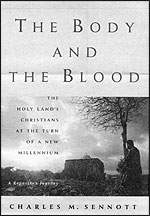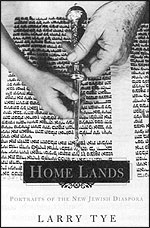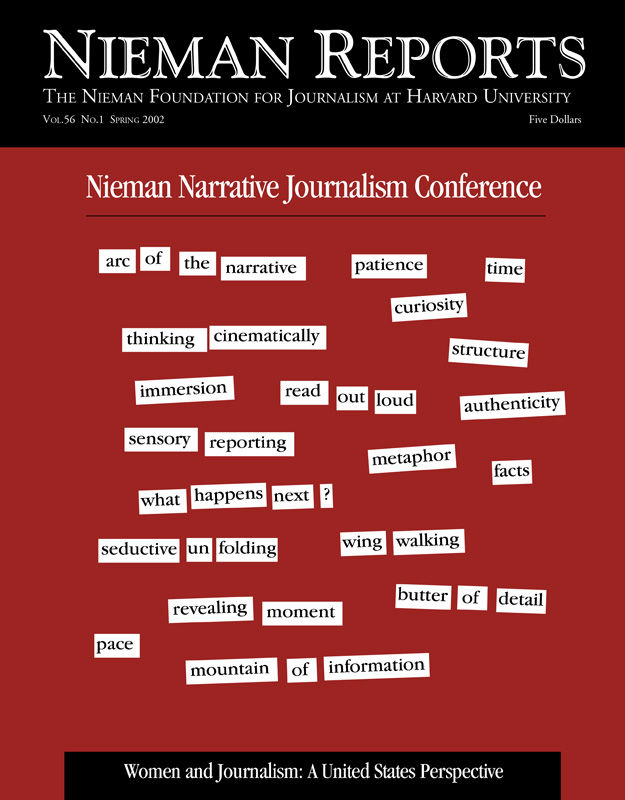
The Body and the Blood: The Holy Land’s Christians at the Turn of a New Millennium
Charles M. Sennott
PublicAffairs. 512 Pages. $30.

Home Lands: Portraits of the New Jewish Diaspora
Larry Tye
Henry Holt & Co. 336 Pages. $27.50.Journalists generally have a reputation for being secular, if not insensitive to matters of religion and faith. So it is gratifying to encounter two books—both by Boston Globe reporters—that examine the contemporary lives of their respective co-religionists. Charles M. Sennott, who from 1997 until last year was the newspaper’s Mideast bureau chief, is an identifying but non-observant Catholic who examines the precarious situation of Christians of all denominations in the Holy Land on the occasion of the 2,000th anniversary of the birth of Jesus. Larry Tye, a 1994 Nieman Fellow, is a strongly identifying, non-Orthodox Jew who travels principally outside the Holy Land to describe Jewish life among those who have chosen not to settle there.
Using the New Testament as a road map of sorts, Sennott travels to the sites that played the principal roles in the life and death of the Christian messiah, including Bethlehem, Nazareth, Egypt and, of course, Jerusalem. The book’s real interest is the political and social challenges facing Christians caught between the rock of what Sennott sees as a chauvinistic Jewish state and the hard place of fellow Arabs who are predominantly Muslim and increasingly intolerant of their Christian brethren. Because of this focus, the book’s “in the footsteps of” structure seems a bit forced, even unnecessary. But if that’s the case, it is only because Sennott has so much interesting material about an otherwise largely ignored group.
Sennott apparently took advantage of his time in Jerusalem to go deep into a subject that was of particular interest to him—the dwindling size of the Christian community in the land that was the birthplace of the faith. His account has the depth and much of the understanding of Israeli society that one would hope for from someone living there.
This is far less the case with Larry Tye’s book, which takes on the daunting challenge of describing Jewish life in eight different places: the author’s native Boston; Atlanta; Buenos Aires; Dnepropetrovsk, Ukraine; Dublin; Düsseldorf; Paris and Israel. Though the criteria Tye used for some of his choices remain obscure, any one of those locations would have provided enough material for a book of its own. Particularly fascinating are two chapters: one includes his interviews with members of the revived Jewish population of Düsseldorf, who are not oblivious to the multiple layers of irony inherent in their presence in a country that was under Nazi rule little more than a half century ago; the other is about Dnepropetrovsk, where some think the Jews number 10,000 and others say 75,000, but all agree that the community’s revival is due to the force of personality of a Lubavitcher rabbi from Brooklyn named Shmuel Kaminezki.
More often than not, however, the chapters in “Home Lands” read like a series of long newspaper features strung together and don’t often exceed the depth that such a format restricts one to. Moreover, whereas Sennott is appropriately gloomy throughout almost all his tale, Tye seems to have felt compelled to put a cheerful gloss on the prospects of each community he describes, even when objective conditions—as he presents them—don’t seem to merit such optimism. At times, this gives him the tone of a cheerleader, doubtless not what he intended.
Tye takes off from a paradoxical starting point: Jews were exiled from their ancestral homeland in the year 70 C.E., and the peripatetic existence they led for the following two millennia is characterized in their collective memory by persecution and longing to return to Zion. Finally, in 1948, they regained an independent state, and that was so dramatic a turnaround that for at least one generation Jews worldwide who refused the imperative to “come home” felt defensive, if not guilty, about their choice to stay put.
Today, argues Tye, a new modus vivendi exists for Diaspora Jewry and Israel. It is a “partnership of equals.” Whereas Israel is “inwardly focused, multifaceted, and increasingly prosperous, although also subject to the volatility of a faltering peace process,” the “metaphor of a people longing to go home” is “outdated,” since the big world has become a secure place to live for the majority of Jews. In other words, it is a win-win situation.
Tye is too savvy a journalist not to understand that with a population of 1,000, the Jewish community of Dublin can’t be long for this world. Nor does he fail to recognize the seriousness of the traumas that the Jews of Buenos Aires have endured during the last decade, including the still-unsolved bombings of the Israeli Embassy there in 1992 and, two years later, of the offices of Asociación Mutual Israelita Argentina (AMIA), the central organization of Argentine Jewry. Between those events, corruption among the leadership of AMIA, and the country’s economic problems (Tye wrote before the country’s latest chapter in bankruptcy), it’s little surprise that Argentina’s Jews are heading for the exits. Even though Tye says in his introduction that he will examine “Jewish communities that are growing and ones on the verge of death,” he always seems to be looking for that silver lining.
As an American-born Jew who chose to settle in Israel and raise a family there, I share an appreciation of both the richness of Diaspora Jewish life and the miracle of the rebirth of a Jewish commonwealth in my people’s historic home. But there are disturbing trends in evidence today, including intermarriage and other symptoms of assimilation among the vast majority of U.S. Jewry, a lack of Jewish pluralism in Israel, and the domination by a corrupt rabbinical establishment of religious life there, to name just a few. Though these trends are touched on by Tye, they don’t prevent him from concluding that there hasn’t been a better time than now to be a Jew. And none of that is to mention—and Tye barely does—the apparent intractability of the Israeli-Palestinian conflict, which continues to threaten the very future of Israel as a state.
The Israeli-Palestinian conflict plays a major role in Sennott’s book, which examines why the Christian population of historic Palestine (Israel, the West Bank, and Gaza) declined from 145,000 during the period of the British Mandate (1917-48) to 133,000 in 1995. Today, no doubt, the number is even smaller. (The author quotes a recent survey showing that half were considering emigrating.) These “living stones,” as the apostle Peter referred to the Holy Land’s indigenous Christians, find themselves both courted and attacked by Muslims and Jews. In Arab Nazareth, in Israel’s Galilee, Jewish politicians, writes Sennott, encouraged local Muslims to push for construction of a mosque in the front yard of the Church of the Annunciation, causing a Christian-Muslim dispute so bitter that it ruined the city’s plans to undertake a makeover on the eve of the Millennium.
Sennott is fully engaged by his subject. He mocks American pilgrims who are surprised to learn that there are Christian Arabs in the land of Jesus. He argues with a Palestinian Christian who describes his admiration of the way the Israelis have “marketed” the Holocaust. He challenges Osama el-Baz, right-hand man to Egyptian President Hosni Mubarak, about his country’s treatment of its shrinking Coptic population. And he describes an encounter with Israeli soldiers guarding the West Bank settlement of Rachelim, after Jewish settlers from there overturned a Palestinian family’s olive harvest and stole their donkey. Sennott convinced the soldiers to let him return the donkey.
I have some quibbles with Sennott’s book, as well. He could have told us more about the descendants of the Crusaders who still live in the Holy Land and should have devoted more than four pages to the dilemma of hundreds of thousands of Christians from the former Soviet Union, who entered Israel as citizens during the 1990’s under the terms of the country’s Law of Return, but who don’t really feel at home. And referring to Israel as “the closest thing to a democracy in the Middle East” seems like a gratuitous swipe. But on balance, his book is a superbly reported, highly credible, sadly moving account of a group whose existence is characterized by irony no less than that of the Jews of Larry Tye’s Düsseldorf.
David B. Green is a 2002 Nieman Fellow. In Israel, he is arts and books editor of The Jerusalem Report.


